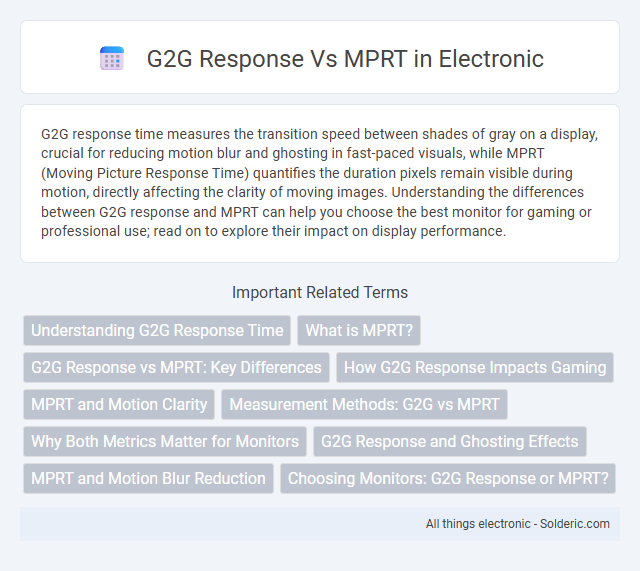G2G response time measures the transition speed between shades of gray on a display, crucial for reducing motion blur and ghosting in fast-paced visuals, while MPRT (Moving Picture Response Time) quantifies the duration pixels remain visible during motion, directly affecting the clarity of moving images. Understanding the differences between G2G response and MPRT can help you choose the best monitor for gaming or professional use; read on to explore their impact on display performance.
Comparison Table
| Feature | G2G Response Time | MPRT (Moving Picture Response Time) |
|---|---|---|
| Definition | Measured time for pixel color transition (gray-to-gray) | Time screen takes to display a moving image without blur |
| Measurement Unit | Milliseconds (ms) | Milliseconds (ms) |
| Focus | Pixel response speed | Perceived motion clarity |
| Usage | Monitor and TV pixel performance | Real-world motion blur assessment |
| Impact | Lower is better for reduced ghosting | Lower is better for clearer moving images |
| Measurement Method | Oscilloscope and photodiode | High-speed camera and specialized tools |
Understanding G2G Response Time
G2G response time measures how quickly a pixel changes from one shade of gray to another, directly impacting motion clarity and reducing motion blur in displays. Unlike MPRT (Moving Picture Response Time), which reflects the total time a pixel is visible during movement, G2G focuses specifically on pixel transition speed, making it a critical factor for gamers seeking smooth visuals. Understanding G2G response time helps you evaluate monitor performance more accurately for fast-paced content.
What is MPRT?
MPRT (Moving Picture Response Time) measures the duration a pixel remains visible before transitioning, impacting motion blur in displays. Unlike G2G (Gray-to-Gray) response, which tracks pixel color shifts between shades of gray, MPRT emphasizes the persistence of images to reduce ghosting effects. Lower MPRT values result in clearer motion rendering, enhancing overall visual performance in fast-paced media.
G2G Response vs MPRT: Key Differences
G2G response time measures the pixel color transition speed from one shade of gray to another, directly impacting motion clarity and ghosting in displays. MPRT (Moving Picture Response Time) quantifies the duration a pixel remains visible during motion, reflecting perceived blur reduction and smoother visuals. The key difference lies in G2G addressing pixel color change speed while MPRT targets motion blur perception, critical for gaming and fast-motion video performance.
How G2G Response Impacts Gaming
G2G response time, measuring pixel color transition speed, directly affects gaming fluidity and visual clarity by reducing motion blur and ghosting during fast-paced scenes. Lower G2G values, typically under 5ms, enhance competitive gameplay by enabling quicker reaction times and sharper image transitions. Unlike MPRT, which assesses perceived blur, G2G response impacts overall frame-to-frame rendering speed crucial for precise input feedback and smooth visuals.
MPRT and Motion Clarity
MPRT (Moving Picture Response Time) directly impacts motion clarity by measuring how quickly a display can refresh transitioning pixels, reducing motion blur and ghosting effects. While G2G response time tracks pixel color changes, MPRT provides a more accurate representation of perceived motion sharpness during fast-moving scenes. Your choice of monitor with low MPRT values enhances gaming and video playback clarity by delivering smoother, more fluid visuals.
Measurement Methods: G2G vs MPRT
G2G response time measures the transition speed between different gray levels on a display, reflecting pixel state changes using specialized testing equipment and software like oscilloscopes or high-speed cameras. MPRT (Moving Picture Response Time) quantifies motion blur by assessing pixel persistence during moving image sequences, often using strobed backlight or photodiode-based measurements. Your choice between G2G and MPRT depends on whether you prioritize raw pixel transition speed or perceived motion clarity in dynamic content.
Why Both Metrics Matter for Monitors
G2G response time measures how fast a pixel changes from one color to another, crucial for reducing motion blur and ghosting in fast-paced gaming or video playback. MPRT (Moving Picture Response Time) quantifies perceived blur during motion, reflecting how clear moving images appear to the human eye. Your choice of monitor should consider both metrics to ensure smooth visuals and reduce eye strain, delivering an optimal viewing experience across different applications.
G2G Response and Ghosting Effects
G2G response time measures the transition speed between shades of gray, directly impacting motion clarity and reducing ghosting effects in displays. Lower G2G response times lead to less motion blur and minimal ghosting, enhancing visual performance in fast-moving scenes. Ghosting occurs when slow pixel response causes a trailing image, which fast G2G response helps to eliminate for a cleaner, sharper image.
MPRT and Motion Blur Reduction
MPRT (Moving Picture Response Time) measures the duration a pixel remains visible on screen, directly impacting motion blur perception by minimizing image persistence during fast-moving scenes. Motion Blur Reduction technologies work by inserting black frames or strobing backlight to shorten perceived MPRT, enhancing visual clarity and smoothness in gaming or fast-action content. Lower MPRT values correspond to sharper, clearer images with reduced motion blur, improving overall display performance in dynamic visuals.
Choosing Monitors: G2G Response or MPRT?
Choosing monitors involves understanding the difference between G2G response time and MPRT, as each measures display speed differently. G2G response time gauges how fast pixels change from one color to another, affecting motion clarity and reducing ghosting in fast-paced scenes. MPRT (Moving Picture Response Time) focuses on the duration a pixel remains visible during motion, providing a more accurate sense of motion blur reduction to enhance your gaming or viewing experience.
G2G response vs MPRT Infographic

 solderic.com
solderic.com